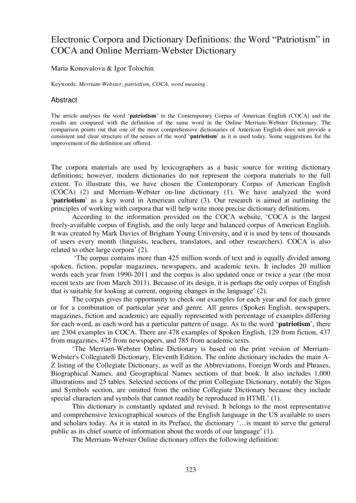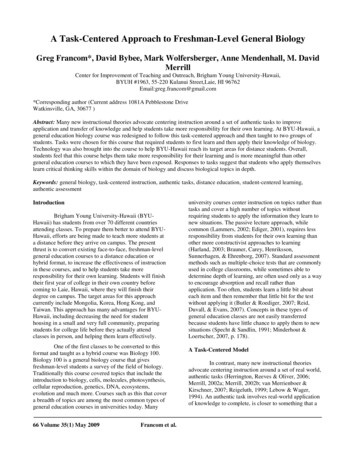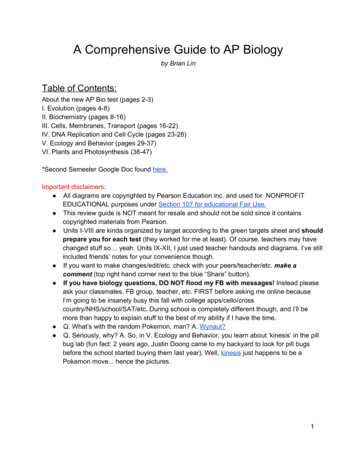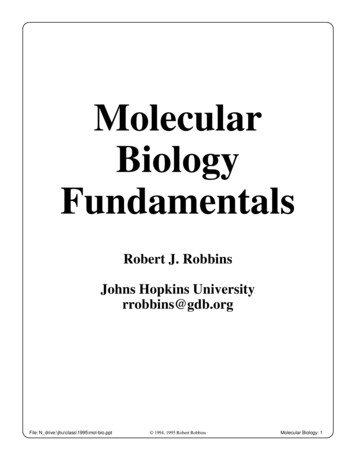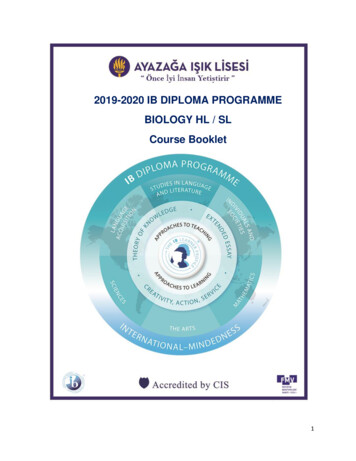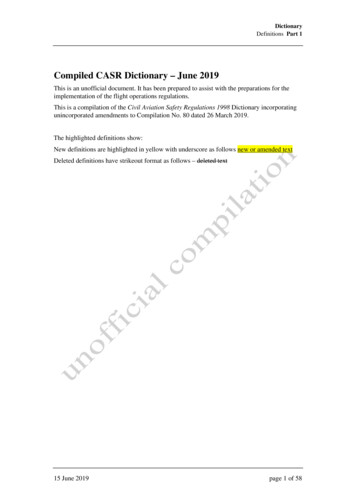
Transcription
Biology DictionaryWeb site:http://www.phschool.com/science/biology place/glossary/index.htmlThis collection of over 1000 biological terms and definitions is available for quick referenceas you use The Biology Place, Classic Edition.ABCDEFGHIJKLMNOPQRSTUVWXYZAAbaxialThe term abaxial (or dorsal) describes a plant part, side or surface facing away from the theaxis of any organ or part; eccentric.AbdomenIn vertebrates, the portion of the trunk containing visceral organs other than heart andlungs; in arthropods, the posterior portion of the body, made up of similar segments andcontaining the reproductive organs and part of the digestive tract.AbioticNonliving; specifically, the nonliving components of an ecosystem, such as temperature,humidity, the mineral content of the soil, etc.AboralUpsied down, : the aboral surface of a starfish.Pertaining to away from the mouth inorganisms with no distinct front or back sidesAbscisic acidA plant hormone that generally acts to inhibit growth, promote dormancy, and help theplant tolerate stressful conditions.AbscissionIn plants, the dropping of leaves, flowers, fruits, or stems at the end of a growing season, asthe result of formation of a two-layered zone of specialized cells (the abscission zone) andthe action of a hormone.AbsorptionThe movement of water and dissolved substances into a cell, tissue, or organism.RGUKT/General BiologyPage 1
Biology DictionaryAbsorption spectrumThe range of a pigment's ability to absorb various wavelengths of light.Abyssal zoneThe portion of the ocean floor where light does not penetrate and where temperatures arecold and pressures intense.AcanthocephalaThe spiny-headed worms, a phylum of helminths; adults are parasitic in the alimentary canalof vertebrates.Accessory cellsAny nonlymphocytic cell that helps in the induction of the immune response by presentingantigen to a helper T lymphocyte.AcoelomatesAn animal that lacks a coelom. Acoelomates, which include the flatworm, fluke, tapeworm,and ribbon worm, exhibit bilateral symmetry and possess one internal space, the digestivecavity.AcclimatizationPhysiological adjustment to a change in an environmental factor.accommodationThe automatic adjustment of an eye to focus on near objects.AcellularContaing no cells; not made of cells.Accessory CellA cell which is associated with the guard cell of a stomaAcetylcholineOne of the most common neurotransmitters; functions by binding to receptors and alteringthe permeability of the postsynaptic membrane to specific ions, either depolarizing orhyperpolarizing the membrane.Acetyl CoAThe entry compound for the Krebs cycle in cellular respiration; formed from a fragment ofpyruvate attached to a coenzyme.AchlamydeousNot having a floral envelope or perianth.RGUKT/General BiologyPage 2
Biology DictionaryAcidA substance that increases the hydrogen ion concentration in a solution.Acid precipitationRain, snow, or fog that is more acidic than pH 5.6.AcoelomateA solid-bodied animal lacking a cavity between the gut and outer body wall.AcrocentricHaving the centromere located near one end of the chromosome so that one chromosomalarm is long and the other is short.AcrosomeAn organelle at the tip of a sperm cell that helps the sperm penetrate the egg.ACTHAbbreviation of adrenocorticotropic hormone.ActinA globular protein that links into chains, two of which twist helically about each other,forming microfilaments in muscle and other contractile elements in cells.ActinomorphicCapable of being divided into equal halves along any diameter, as the flowers of the rose ortulip; radially symmetrical.Action potentialA rapid change in the membrane potential of an excitable cell, caused by stimulus-triggered,selective opening and closing of voltage-sensitive gates in sodium and potassium ionchannels.Activation energyThe energy that must be possessed by atoms or molecules in order to react.Active siteThe specific portion of an enzyme that attaches to the substrate by means of weak chemicalbonds.Active transportThe movement of a substance across a biological membrane against its concentration orelectrochemical gradient, with the help of energy input and specific transport proteins.RGUKT/General BiologyPage 3
Biology DictionaryAdaptationThe evolution of features that make a group of organisms better suited to live andreproduce in their environment.Adaptive peakAn equilibrium state in a population when the gene pool has allele frequencies thatmaximize the average fitness of a population's members.Adaptive radiationThe emergence of numerous species from a common ancestor introduced into anenvironment, presenting a diversity of new opportunities and problems.Adenosine diphosphateA nucleotide consisting of adenine, ribose, and two phosphate groups; formed by theremoval of one phosphate from an ATP molecule.Adenosine monophosphateA nucleotide consisting of adenine, ribose, and one phosphate group; can be formed by theremoval of two phosphates from an ATP molecule; in its cyclic form, functions as a "secondmessenger" for a number of vertebrate hormones and neurotransmitters.Adenosine triphosphateAn adenine-containing nucleoside triphosphate that releases free energy when itsphosphate bonds are hydrolyzed. This energy is used to drive endergonic reactions in cells.Adenylyl cyclaseAn enzyme that converts ATP to cyclic AMP in response to a chemical signal.ADHAbbreviation of antidiuretic hormone.AdhesionThe tendency of different kinds of molecules to stick together.ADPAbbreviation of adenosine diphosphate.AdaxialIn botany terminology adaxial describes a side or surface nearest or facing toward the axisof an organ or organism, such as the upper surface of a leaf laminaRGUKT/General BiologyPage 4
Biology DictionaryAdipocytesAny of various cells found in adipose tissue that are specialized for the storage of fat. Alsocalled adipocyte.AdnateUnlike parts or organs; growing closely attachedAdrenal glandAn endocrine gland located adjacent to the kidney in mammals; composed of two glandularportions: an outer cortex, which responds to endocrine signals in reacting to stress andeffecting salt and water balance, and a central medulla, which responds to nervous inputsresulting from stress.AdrenalineA hormone, produced by the medulla of the adrenal gland, that increases the concentrationof glucose in the blood, raises blood pressure and heartbeat rate, and increases muscularpower and resistance to fatigue; also a neurotransmitter across synaptic junctions. Alsocalled epinephrine.Adrenocorticotropic hormone (ACTH)A hormone, produced by the anterior lobe of the pituitary gland, that stimulates theproduction of cortisol by the adrenal cortex.AdventitiousReferring to a structure arising from an unusual place, such as roots growing from stems orleaves.AerenchymaA spongy tissue with large air spaces found between the cells of the stems and leaves ofaquatic plants, providing buoyancy and allowing the circulation of gases.AerobicContaining oxygen; referring to an organism, environment, or cellular process that requiresoxygen.AerialExsiting or living in the air.RGUKT/General BiologyPage 5
Biology DictionaryAestivationCessation from or slowing of activity during the summer; especially slowing of metabolismin some animalsAfferentBringing inward to a central part, applied to nerves and blood vessels.AgarA gelatinous material prepared from certain red algae that is used to solidify nutrient mediafor growing microorganisms.Age structureThe relative number of individuals of each age in a population.AgnathanA member of a jawless class of vertebrates represented today by the lampreys andhagfishes.Agonistic behaviorA type of behavior involving a contest of some kind that determines which competitor gainsaccess to some resource, such as food or mates.AlburnumThe outer zone of wood in a tree, next to the bark. Sapwood is generally lighter thanheartwood.AIDS (acquired immunodeficiency syndrome)The name of the late stages of HIV infection; defined by a specified reduction of T cells andthe appearance of characteristic secondary infections.AirsacsAn air-filled space in the body of a bird that forms a connection between the lungs and bonecavities and aids in breathing and temperature regulation.AldehydeAn organic molecule with a carbonyl group located at the end of the carbon skeleton.AldosteroneAn adrenal hormone that acts on the distal tubules of the kidney to stimulate thereabsorption of sodium (Na ) and the passive flow of water from the filtrate.RGUKT/General BiologyPage 6
Biology DictionaryAleurone layerThe outermost cell layer of the endosperm of the grains (seeds) of wheat and other grasses;when acted upon by gibberellin, the aleurone layer releases enzymes that digest the storedfood of the endosperm into small nutrient molecules that can be taken up by the embryo.AlgaeA photosynthetic, plantlike protist.AlligatorEither of two large reptiles, Alligator mississipiensis of the southeast United States or A.sinensis of China, having sharp teeth and powerful jaws. They differ from crocodiles inhaving a broader, shorter snout.Alimentary canalThe tube or passage of the digestive system through which food passes, nutrients areabsorbed, waste is eliminated.AlkalinitypH values above 7.AlkalinePertaining to substances that increase the relative number of hydroxide ions (OH–) in asolution; having a pH greater than 7; basic; opposite of acidic.AlkaloidsA type of chemical commonly found in plants and often having medical properties. e.g.:atropine, caffeine, morphine, nicotine, quinine.All-or-none eventAn action that occurs either completely or not at all, such as the generation of an actionpotential by a neuron.AllantoisOne of four extraembryonic membranes; serves as a repository for the embryo'snitrogenous waste.AlleleAn alternative form of a gene.Allele frequencyThe proportion of a particular allele in a population.RGUKT/General BiologyPage 7
Biology DictionaryAllergic reactionAn inflammatory response triggered by a weak antigen (an allergen) to which mostindividuals do not react; involves the release of large amounts of histamine from mast cells.Allometric growthThe variation in the relative rates of growth of various parts of the body, which helps shapethe organism.Allopatric speciationA mode of speciation induced when the ancestral population becomes segregated by ageographical barrier.AllopolyploidA common type of polyploid species resulting from two different species interbreeding andcombining their chromosomes.Allosteric siteA specific receptor site on an enzyme molecule remote from the active site. Molecules bindto the allosteric site and change the shape of the active site, making it either more or lessreceptive to the substrate.AllozymesSlightly different versions of the same enzyme, distinguishable via gel electrophoresis.Alpha helixA spiral shape constituting one form of the secondary structure of proteins, arising from aspecific hydrogen-bonding structure.Alternation of generationsA life cycle in which there is both a multicellular diploid form, the sporophyte, and amulticellular haploid form, the gametophyte; characteristic of plants.Alternative splicingIn alternative splicing, the same pre-mRNA molecule, which consists of introns and exons, isspliced in different ways to produce mature mRNAs of different lengths and differentfunctionality.Altruistic behaviorThe aiding of another individual at one's own risk or expense.RGUKT/General BiologyPage 8
Biology DictionaryAlveolusOne of the deadend, multilobed air sacs that constitute the gas exchange surface of thelungs. Or One of the milk-secreting sacs of epithelial tissue in the mammary glands.Amino acidsAn organic molecule possessing both carboxyl and amino groups. Amino acids serve as themonomers of proteins.Amino groupA functional group that consists of a nitrogen atom bonded to two hydrogen atoms; can actas a base in solution, accepting a hydrogen ion and acquiring a charge of 1.AminoacylA family of enzymes, at least one for each amino acid, that catalyze the attachment of anamino acid to its specific tRNA molecule.AmitosisDirect cell devision, that is, the cell divides by simple cleavage of the nucles withoutformation of spireme spindle figures or chromosomes.AmmonificationThe process by which decomposers break down proteins and amino acids, releasing theexcess nitrogen in the form of ammonia (NH3) or ammonium ion (NH4 ).AmniocentesisA technique for determining genetic abnormalities in a fetus by the presence of certainchemicals or defective fetal cells in the amniotic fluid, obtained by aspiration from a needleinserted into the uterus.AmnionThe innermost of four extraembryonic membranes; encloses a fluid-filled sac in which theembryo is suspended.AmnioteA vertebrate possessing an amnion surrounding the embryo; reptiles, birds, and mammalsare amniotes.Amniotic eggA shelled, water-retaining egg that enables reptiles, birds, and egg-laying mammals tocomplete their life cycles on dry land.RGUKT/General BiologyPage 9
Biology DictionaryAmoeboidMoving or feeding by means of pseudopodia (temporary cytoplasmic protrusions from thecell body).AMPAbbreviation of adenosine monophosphate.AmphibiaThe vertebrate class of amphibians, represented by frogs, salamanders, and caecilians.AmphibiousLiving or able to live both land and water.Amphipathic moleculeA molecule that has both a hydrophilic region and a hydrophobic region.AmphioxusAny of various small, flattened marine organisms of the subphylum Cephalochordata,structurally similar to the vertebrates but having a notochord rather than a true vertebralcolumn. Also called amphioxus.AmphotericHaving the characteristics of an acid and a base and capable of reacting chemically either asan acid or a base.Amphistomatic.Of a leaf, Having stomata on both surfacesAmylopectinThe outer protion of a starch granule consisting of insoluble, highly branchedpolysaccharides of high molecular weight.Amyloplasts/ starch plastidsAmyloplasts are non-pigmented organelles found in plant cells responsible for the storage ofamylopectin, a from of starch, through the polymerization of glucose. Amyloplasts alsoconvert this starch into sugar, for when the plant needs energy.Anabolic steroidsSynthetic chemical variants of the male sex hormone testosterone; they produce increasedmuscle mass but also suppress testosterone production, leading to shrinkage of the testes,growth of the breasts, and premature baldness; long-term use increases the risk of kidneyand liver damage and of liver cancer.RGUKT/General BiologyPage 10
Biology DictionaryAnabolismWithin a cell or organism, the sum of all biosynthetic reactions (that is, chemical reactions inwhich larger molecules are formed from smaller ones).AnaerobicLacking oxygen; referring to an organism, environment, or cellular process that lacks oxygenand may be poisoned by it.AnagenesisA pattern of evolutionary change involving the transformation of an entire population,sometimes to a state different enough from the ancestral population to justify renaming itas a separate species; also called phyletic evolution.AnalogyThe similarity of structure between two species that are not closely related; attributable toconvergent evolution.AnalogousApplied to structures similar in function but different in evolutionary origin, such as the wingof a bird and the wing of an insect.AnaphaseThe third stage of mitosis, beginning when the centromeres of duplicated chromosomesdivide and sister chromotids separate from each other, and ending when a complete set ofdaughter chromosomes are located at each of the two poles of the cell.AnatomyThe morphological structure of a plant or an animal or of any of its parts.AndroeciumThe male reproductive organs of a flower considered as a group; the stamens. Comparegynoecium.AndrogenThe principal male steroid hormones, such as testosterone, which stimulate thedevelopment and maintenance of the male reproductive system and secondary sexcharacteristics.AneuploidyA chromosomal aberration in which certain chromosomes are present in extra copies or aredeficient in number.RGUKT/General BiologyPage 11
Biology DictionaryAngiospermsA flowering plant, which forms seeds inside a protective chamber called an ovary.AnimaliaAnimals are a major group of multicellular organisms, of the kingdom Animalia or metazoa.animal starchOne form in which body is fuel is stored; stored primarily in the liver and broken down intoglucose when needed by the body.AnisogamousA union between two gametes that differ in size of form.AnionA negatively charged ion.AnklebonesThe bone in the ankle that articulates with the leg bones to form the ankle jointAnnualA plant that completes its entire life cycle in a single year or growing season.AntennaeLong, paired sensory appendages on the head of many arthropods.AnteriorReferring to the head end of a bilaterally symmetrical animal.AntherThe terminal pollen sac of a stamen, inside which pollen grains with male gametes form inthe flower of an angiosperm.AntheridiumIn plants, the male gametangium, a moist chamber in which gametes develop.AnthocyaninNatural water-soluble pigments of blue, purple or red which are dissolved in the cell-sapvacuole of plant cells.AnthropoidA higher primate; includes monkeys, apes, and humans.AntibioticA chemical that kills bacteria or inhibits their growth.RGUKT/General BiologyPage 12
Biology DictionaryAntibiotic resistanceAntibiotic resistance is the ability of a microorganism to withstand the effects of anantibiotic. It is a specific type of drug resistance.AntibodyAn antigen-binding immunoglobulin, produced by B cells, that functions as the effector in animmune response.AnticodonA specialized base triplet on one end of a tRNA molecule that recognizes a particularcomplementary codon on an mRNA molecule.Antidiuretic hormone (ADH)A hormone important in osmoregulation.AntigenA foreign macromolecule that does not belong to the host organism and that elicits animmune response.AnusThe opening at the lower end of the digestive tract through which solid waste is excreated.AnuransAny of numerous tailless, aquatic, semiaquatic, or terrestrial amphibians of the order Anuraand especially of the family Ranidae, characteristically having a smooth moist skin, webbedfeet, and long hind legs adapted for leaping.AortaThe major artery in blood-circulating systems; the aorta sends blood to the other bodytissues.AppendicularElating to, or consisting of an appendage or appendages, especially the limbs: theappendicular skeleton.Aphotic zoneThe part of the ocean beneath the photic zone, where light does not penetrate sufficientlyfor photosynthesis to occur.Apical dominanceConcentration of growth at the tip of a plant shoot, where a terminal bud partially inhibitsaxillary bud growth.RGUKT/General BiologyPage 13
Biology DictionaryApical meristemEmbryonic plant tissue in the tips of roots and in the buds of shoots that supplies cells forthe plant to grow in length.ApocarpousConsisting of carpels that are free from one another as in buttercups or roses.Apomorphic characterA derived phenotypic character, or homology, that evolved after a branch diverged from aphylogenetic tree.ApoplastIn plants, the nonliving continuum formed by the extracellular pathway provided by thecontinuous matrix of cell walls.ApoptosisProgrammed cell death brought about by signals that trigger the activation of a cascade of"suicide" proteins in the cells destined to die.Aposematic colorationThe bright coloration of animals with effective physical or chemical defenses that acts as awarning to predators.AquaporinA transport protein in the plasma membranes of a plant or animal cell that specificallyfacilitates the diffusion of water across the membrane (osmosis).AquticConsisting of, relating to, or being in water; an aquatic environment.Aqueous solutionA solution in which water is the solvent.ArborealTree-dwelling.ArchaeaOne of two prokaryotic domains, the other being the Bacteria.ArchesArches are curved structures, arch-like in profile, which span the foot.RGUKT/General BiologyPage 14
Biology DictionaryArchenteronThe central cavity of the gastrula, which ultimately becomes the intestinal or digestivecavity.ArchegoniumIn plants, the female gametangium, a moist chamber in which gametes develop.ArchenteronThe endoderm-lined cavity, formed during the gastrulation process, that develops into thedigestive tract of an animal.ArchezoaPrimitive eukaryotic group that includes diplomonads, such as Giardia; some systematistsassign kingdom status to archezoans.ArterioleA very small artery. See also artery.ArteriesArteries are blood vessels that carry blood away from the heartArteryA vessel that carries blood away from the heart to organs throughout the body.ArteriosclerosisA cardiovascular disease caused by the formation of hard plaques within the arteries.Artificial selectionThe selective breeding of domesticated plants and animals to encourage the occurrence ofdesirable traits.AscusA saclike spore capsule located at the tip of the ascocarp in dikaryotic hyphae; definingfeature of the Ascomycota division of fungi.Asexual reproductionA type of reproduction involving only one parent that produces genetically identicaloffspring by budding or by the division of a single cell or the entire organism into two ormore parts.RGUKT/General BiologyPage 15
Biology DictionaryAschelminthThe Aschelminthes (also known as Aeschelminthes, Nemathelminthes, orPseudocoelomata), closely associated with the Platyhelminthes, are an obsolete phylum ofpseudocoelomate and other similar animals that are no longer considered closely relatedand have been promoted to phyla in their own right.AssimilationThe energy-requiring process by which plant cells convert nitrate ions (NO3–) taken up bythe roots of plants into ammonium ions (NH4 ), which can then be used in the synthesis ofamino acids and other nitrogenous compounds.Associative learningThe acquired ability to associate one stimulus with another; also called classicalconditioning.Assortative matingA type of nonrandom mating in which mating partners resemble each other in certainphenotypic characters.AstragalusThe bone of the ankle which articulates with the bones of the leg. Also known as talus.AstrocytesA star-shaped cell, especially a neuroglial cell of nervous tissue.AsymmetricalIrregular in shape or outline.Asymmetric carbonA carbon atom covalently bonded to four different atoms or groups of atoms.AtactosteleA type of monocotyledonous siphonostele in which the vascular bundles are dispersedirregularly throughout the center of the stem.Atmospheric pressureThe weight of the Earth's atmosphere over a unit area of the Earth's surface.AtomThe smallest unit of matter that retains the properties of an element.Atomic massThe mass of an atom of a chemical element expressed in atomic mass units.RGUKT/General BiologyPage 16
Biology DictionaryAtomic numberThe number of protons in the nucleus of an atom, unique for each element and designatedby a subscript to the left of the elemental symbol.Atomic TheoryThe physical theory of the structure, properties, and behavior of the atom.Atomic weightThe total atomic mass, which is the mass in grams of one mole of the atom.ATPAbbreviation of adenosine triphosphate, the principal energy-carrying compound of the cell.ATP synthaseA cluster of several membrane proteins found in the mitochondrial cristae (and bacterialplasma membrane) that function in chemiosmosis with adjacent electron transport chains,using the energy of a hydrogen-ion concentration gradient to make ATP. ATP synthasesprovide a port through which hydrogen ions diffuse into the matrix of a mitrochondrion.Atrioventricular nodeA group of slow-conducting fibers in the atrium of the vertebrate heart that are stimulatedby impulses originating in the sinoatrial node (the pacemaker) and that conduct impulses tothe bundle of His, a group of fibers that stimulate contraction of the ventricles.Atrioventricular valveA valve in the heart between each atrium and ventricle that prevents a backflow of bloodwhen the ventricles contract.AtriumA chamber that receives blood returning to the vertebrate heart.AuriclesThe flap of the ear in the form of a funnel-like organ which collects the sound waves. Calledalso pinna.AutocatalysisA single chemical reaction is said to have undergone autocatalysis, or be autocatalytic, ifthe reaction product is itself the catalyst for that reaction.AutoeciousHaving all stages of a life cycle occurring on the same host. Eg.; fungiRGUKT/General BiologyPage 17
Biology DictionaryAutogenesis modelAccording to this model, eukaryotic cells evolved by the specialization of internalmembranes originally derived from prokaryotic plasma membranes.Autoimmune diseaseAn immunological disorder in which the immune system turns against itself.Autonomic nervous systemA subdivision of the motor nervous system of vertebrates that regulates the internalenvironment; consists of the sympathetic and parasympathetic divisions.AutopolyploidA type of polyploid species resulting from one species doubling its chromosome number tobecome tetraploid, which may self-fertilize or mate with other tetraploids.AutosomesA chromosome that is not directly involved in determining sex, as opposed to the sexchromosomes.AutotrophAn organism that obtains organic food molecules without eating other organisms.Autotrophs use energy from the sun or from the oxidation of inorganic substances to makeorganic molecules from inorganic ones.Autumn woodThe season of the year between summer and winter, lasting from the autumnal equinox tothe winter solstice and from September to December in the Northern Hemisphere; fall.AuxinA class of plant hormones, including indoleacetic acid (IAA), having a variety of effects, suchas phototropic response through the stimulation of cell elongation, stimulation of secondarygrowth, and the development of leaf traces and fruit.AuxotrophA nutritional mutant that is unable to synthesize and that cannot grow on media lackingcertain essential molecules normally synthesized by wild-type strains of the same species.AvesThe vertebrate class of birds, characterized by feathers and other flight adaptations.AxialRelating to, characterized by, or forming an axis.RGUKT/General BiologyPage 18
Biology DictionaryAxileSituated along the central axis of an ovary having two or more locules.Axillary budsAn embryonic shoot present in the angle formed by a leaf and stem.Axial filamentsThe central filament of a flagellum or cilium. Also called axoneme.AxisAn imaginary line passing through a body or organ around which parts are symmetricallyaligned.AxonA typically long extension, or process, from a neuron that carries nerve impulses away fromthe cell body toward target cells.BB cellA type of lymphocyte that develops in the bone marrow and later produces antibodies,which mediate humoral immunity.Bacilli (pl.) Bacillus (Sin.)Aerobic rod-shaped spore-producing bacterium; often occurring in chainlike formationsBacteriaOne of two prokaryotic domains, the other being the Archaea.BacteriophageA virus that parasitizes a bacterial cell.Bacterium (Sin.) Bacteria (Pl.)A prokaryotic microorganism in Domain Bacteria.Balanced polymorphismA type of polymorphism in which the frequencies of the coexisting forms do not changenoticeably over many generations.BarkAll tissues external to the vascular cambium in a plant growing in thickness, consisting ofphloem, phelloderm, cork cambium, and cork.RGUKT/General BiologyPage 19
Biology DictionaryBarr bodyA dense object lying along the inside of the nuclear envelope in female mammalian cells,representing an inactivated X chromosome.BasalLocated at or near the base of a plant stem, or at the base of any other plant part.Basal bodyA eukaryotic cell organelle consisting of a 9 0 arrangement of microtubule triplets; mayorganize the microtubule assembly of a cilium or flagellum; structurally identical to acentriole.Basal metabolic rate (BMR)The minimal number of kilocalories a resting animal requires to fuel itself for a given time.BaseA substance that reduces the hydrogen ion concentration in a solution.Basement membraneThe floor of an epithelial membrane on which the basal cells rest.Base-pair substitutionA point mutation; the replacement of one nucleotide and its partner from thecomplementary DNA strand by another pair of nucleotides.Base-pairing principleIn the formation of nucleic acids, the requirement that adenine must always pair withthymine (or uracil) and guanine with cytosine.BasidiumA reproductive appendage that produces sexual spores on the gills of mushrooms. Thefungal division Basidiomycota is named for this structure.BasifixedAttached by the base, as certain anthers are to their filaments.Batesian mimicryA type of mimicry in which a harmless species looks like a different species that is poisonousor otherwise harmful to predators.BehaviorAll of the acts an organism performs, as in, for example, seeking a suitable habitat, obtainingfood, avoiding predators, and seeking a mate and reproducing.RGUKT/General BiologyPage 20
Biology DictionaryBehavioral ecologyA heuristic approach based on the expectation that Darwinian fitness (reproductive success)is improved by optimal behavior.Benthic zoneThe bottom surfaces of aquatic environments.BenignNot life-threatening or severe, and likely to respond to treatment, as a tumor that is notmalignant.BiannualsOccurring twice a year.BiennialA plant that requires two years to complete its life cycle.Bilateral symmetryCharacterizing a body form with a central longitudinal plane that divides the body into twoequal but opposite halves.BilateriaMembers of the branch of eumetazoans possessing bilateral symmetry.BileA yellow secretion of the vertebrate liver, temporarily stored in the gallbladder andcomposed of organic salts that emulsify fats in the small intestine.Binary fissionThe type of cell divisi
Biology Dictionary RGUKT/General Biology Page 9 Alveolus One of the deadend, multilobed air sacs that constitute the gas exchange surface of the lungs. Or One of the milk-secreting sacs of epithelial tissue in the mammary glands. Amino acids An organic molecule possessing both carboxyl and amino groups. Amino acids serve as the



